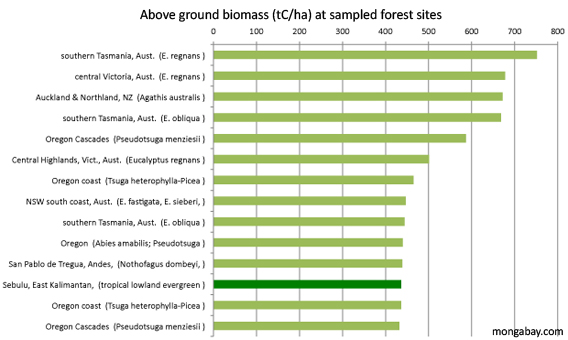|
|
Temperate forests trump rainforests when it comes to storing carbon, reports a new assessment of global forest carbon stocks published July 14th in Proceedings of the National Academy of Sciences (PNAS). The findings have important implications for efforts to mitigate climate change by protecting forests.
Sampling and reviewing published data from nearly 100 forest sites around the world, Heather Keith, Brendan G. Mackey, and David B. Lindenmayer of Australian National University found that Australia’s temperate Eucalyptus forests are champions of carbon storage, sequestering up to 2,844 metric tons of carbon per hectare (in above- and below-ground biomass), a figure that far exceeds previous estimates. These forests, located in the Central Highlands of Victoria in southeastern Australia, are dominated by giant Mountain Ash (Eucalyptus regnans) trees, which can reach a height of 320 feet and live for more than 350 years. They are also favored by the timber industry. Mountain Ash forests have been widely logged across Australia, with only limited old-growth stands remaining. In Tasmania less than 15 percent of Mountain Ash forests remain unlogged.
Overall temperate moist forests stored an average of 377 tons of carbon in above-ground biomass (vegetation) across 18 sites, followed by subtropical moist forests at 294 tons of carbon across 26 sites, tropical moist forests at 179 tons across 14 sites, cool temperate dry forests at 176 tons across three sites, and tropical rainforests at 171 tons across 18 sites.
 Forest carbon storage according to the study.  Forest carbon storage cited in the study compared with IPCC default values.  Top forest carbon storage sites at locations cited in the study. |
The figures are substantially higher than default biomass carbon values used by the Intergovernmental Panel on Climate Change (IPCC) to calculate emissions from deforestation and degradation, and indicate that conservation of old-growth temperate forests should be a high priority in efforts to reduce greenhouse gas emissions from forestry. The study will likely embolden green campaigners seeking to bar logging from old-growth forests. The research has already upset the timber industry in Australia, which maintains that logging is “carbon-positive” (i.e. removes carbon from, rather than contributing it to, atmosphere). In an editorial published Thursday on Online Opinion, Austrlian forester Mark Poynter, argued that restricting logging in Australia would result in more emissions by shifting activities overseas to places where forest management is less stringent.
Heather Keith, Brendan G. Mackey, and David B. Lindenmayer. Re-evaluation of forest biomass carbon stocks and lessons from the world’s most carbon-dense forests. PNAS July 14, 2009 vol. 106 no. 28
Related articles
A Tasmanian tragedy? : How the forestry industry has torn an island apart

(07/02/2009) This is by no means a new battle: in fact, Tasmanian industrial foresters and environmentalists have been fighting over the issue of clearcutting the island’s forests for decades. The battle—some would probably prefer ‘war’—is over nothing less than the future of Tasmania. Some Tasmanians see the rich forests that surround them in terms of income, dollars and cents; they see money literally growing on trees, or more appropriately growing on monoculture plantations and government owned native forests. They see the wilderness of Tasmania as an exploitative resource.
Old growth forests are carbon sinks for centuries, helping offset emissions
(09/11/2009) Old growth forests are important carbon sinks that help global warming, reports a study published in the journal Nature. The results run counter to claims by the forestry industry that old growth forests are carbon neutral or even net emitters of carbon dioxide.